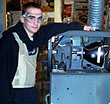|
|
 
|
|
Author
|
Topic: Processor to amplifier wiring
|
|
|
|
|
|
|
|
|
|
|
|
|
|
|
|
|
|
|
|
|
|
|
|
|
|
|
Frank Angel
Film God

Posts: 5305
From: Brooklyn NY USA
Registered: Dec 1999
|
 posted 02-20-2005 05:46 AM
posted 02-20-2005 05:46 AM





You have a much better chance of it being done right, if it is being built from scratch. Assuming the electrical contractor knows what he's doing and you can get the contractor who is installing the booth equipment to TALK to one another, you will be ahead of the game.
It's usually when you are dealing with booths that have had stuff added and subtracted and added again over the years that you find bizarre problems. One balanced legs get unbalanced by loads being hooked up in disregard of distributing the amperage loads evenly across the legs (many times the only regard for balanced load distribution is an electrician opening up a breaker box and looking for a spare breaker, and THAT's where he adds another 50 amp load). If everything is referenced properly back to the ground point, which is easy when you are doing a new construction, there will be no ground loops, even if shields are not properly connected. After all, in homes people routinely hook up unbalanced equipment willy-nilly and those are almost always without benefit of input or output transformers. Why don't they see nasty ground loops with the frequency that they are found in commercial setups? Because usually EVERYTHING is pluged into one or two sockets in the same room all run to the same leg of the mains and usually to single phase.
In old commercial buildings and theatres, there are mulitple legs feeding multiple parts of the building and pieces of equipment in desparate configurations, many of which are not in close physical proximity yet still need to be connected together by their audio connection -- a condition that is ripe for ground loops.
In the studio that I work in, when I first to there, everything was so hot that you could cause a hum just by placing your had on a piece of equipment. If you leaned on any metal part of the sound console, it would start to hum. I took a meter and measured the potental between the ground point on an AC outlet on one side to the ground point on the AC outlet on the other side of the room, literally only 20 feet away and there was a voltage of +17 volts. With +1V = 100% audio modulation, it is any wonder what +17V hanging around everything will do to audio gear not properly grounded. Even "electronically balanced" inputs can't reject ground potentials that far off the mark. We ran copper from every outlet back to the best ground we could find. And that helped, but it certainly made everyone aware that zero Earth is not an equal opportunity potential.
People think that all you have to do is mount everything in the same rack and there will never be any ground differential between pieces of equipment in the same rack. Oh contrair, paint and different types of anodized screws can cause the absolutely uniform grounding that one might expect to see by virtue of screwing a piece of equipment into a rack, to be less reliable than one might think, especially those rack mounts that include side wings which are added so as to make units "rack mountable."
Then there's the old RCA Technical School rule for eliminating ground loops. They called it the RCA Snip & Solder test. It consisted of the technican turning up the volume until hum could be heard. Then he would find the shield on the input of that device and he would cut it. If the hum got louder he would resolder it....if it got lower, he would leave it cut. He would also tie it to the chassis to see if that made any change. Not exactly the most comprehensive approach, but it worked often enough for them to try this method first before biting off bigger fish to fry.
| IP: Logged
|
|
|
|
All times are Central (GMT -6:00)
|
|
Powered by Infopop Corporation
UBB.classicTM
6.3.1.2
The Film-Tech Forums are designed for various members related to the cinema industry to express their opinions, viewpoints and testimonials on various products, services and events based upon speculation, personal knowledge and factual information through use, therefore all views represented here allow no liability upon the publishers of this web site and the owners of said views assume no liability for any ill will resulting from these postings. The posts made here are for educational as well as entertainment purposes and as such anyone viewing this portion of the website must accept these views as statements of the author of that opinion
and agrees to release the authors from any and all liability.
|

 Home
Home
 Products
Products
 Store
Store
 Forum
Forum
 Warehouse
Warehouse
 Contact Us
Contact Us




 Printer-friendly view of this topic
Printer-friendly view of this topic









![[Roll Eyes]](rolleyes.gif)







